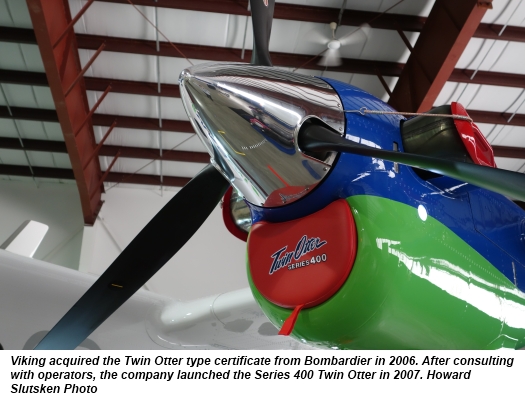Estimated reading time 4 minutes, 58 seconds.

Viking Air of British Columbia has reached a milestone in the production of the new Viking DHC-6 Series 400 Twin Otter. On Feb. 27, the 50th production aircraft was rolled out at a special event at Viking’s facility at Victoria International Airport. Destined for MASwings of Malaysia, this aircraft marks the fifth delivery of a six-aircraft order.
In front of an enthusiastic audience of hundreds of Viking employees, president and CEO David Curtis talked about the Series 400 deliveries that have been made since the plane’s entry-into-service in 2010. New Twin Otters have been delivered to 23 countries, and will soon be certified for delivery worldwide.
“One of the countries I’m most proud of is Russia,” said Curtis. “We’ve got nine sold to the country; we’re hoping to sell more. Here’s this airplane, and it’s going to open up their north, just like it did in Canada.”
The Series 400 is also the first Western-built plane ever purchased by Vietnam. Curtis said, “Imagine you’re in Hanoi, there’s 30 Vietnamese Department of National Defence people sitting on one side, and there’s three of us [from Viking] on the other side. We’re negotiating a $70 million contract, and hadn’t built a single airplane yet. And we delivered.”

The original Twin Otter was manufactured by de Havilland Canada (DHC) in Toronto, with over 800 aircraft produced from 1965 until the line was shut down in 1988. More than 600 of the original aircraft are still flying, worldwide. Over the years, Viking had been instrumental in supporting the fleet as an official DHC customer service centre, with the rights to manufacture and provide parts for the DHC-2 Beaver, the DHC-3 Otter, and ultimately, the Twin Otter.
This successful spare parts business led Viking, in 2006, to acquire the type certificate (TC) for the Twin Otter from Bombardier, which held the TC after its purchase of de Havilland Canada in 1992. This gave Viking full ownership and responsibility for the Twin Otter’s design. In addition to the Twin Otter, Viking also acquired the TCs for all of the heritage de Havilland Canada aircraft, from the DHC-1 Chipmunk, through to the DHC-7 Dash 7.
Once Viking had the TC in hand, they held a Twin Otter operators’ forum to investigate the possibility of re-starting production of the venerable short takeoff and landing utility plane. Part of the challenge that faced Viking was the longevity of the existing fleet. “The Twin Otter is limited to 123,000 landings,” Curtis told Canadian Skies, “and there’s an update coming to double that lifetime.” Viking needed to convince existing operators to replace their older Twin Otters with a new Series 400, and also find new buyers. So, after additional market research and analysis, the Twin Otter Series 400 was launched in 2007, and orders started coming in.
Structurally, the new plane is the same as the Series 300, with consistent performance. Operators knew what their existing aircraft could do, and the new Series 400 would do the same, but be new and improved. The Series 400 incorporates over 800 changes from the previous aircraft, with major upgrades to the internal systems. A more powerful version of the legendary Pratt & Whitney Canada PT-6 turboprop powers the new Twin Otter. And a flat-panel, Honeywell Primus Apex fully digital, integrated avionics suite is a huge technological upgrade from the Series 300’s “steam” gauges.

Major fabrication of the components for the Twin Otter takes place at Viking’s facility in Victoria, with final assembly in Calgary. The completed aircraft are flown to Spokane, Wash., for painting, and then to Victoria for final flight testing, option integration and delivery.
Viking Air has 100 orders on the books, including the 50 already delivered. The Series 400 is being built at a rate of 24 aircraft per year, so production is committed for at least the next two years. The plane is generating interest from operators around the world, and Viking’s early Series 400 customers are so pleased that some have already added additional planes to their fleets.
But what does Curtis really want? “I need to deliver one in Canada! I’m working on that….hard.”








